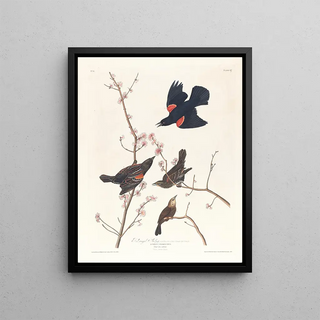Art print | Red-winged Blackbird - John James Audubon


View from behind

Frame (optional)
Étourneau à ailes rouges - John James Audubon – Captivating Introduction
Within the fascinating universe of ornithological art, the "Étourneau à ailes rouges" by John James Audubon stands out for its striking beauty and meticulous attention to detail. This iconic piece, which captures the very essence of the bird in its natural habitat, invites viewers to immerse themselves in a world where nature and art meet in perfect harmony. The depiction of this starling, with its vibrant colors and lively expression, evokes a sense of movement and vitality, reflecting Audubon's passion for birds and their environment. Contemplating this art print, one immediately perceives the importance of wildlife conservation and the fleeting beauty of nature.
Style and uniqueness of the work
Audubon's work is distinguished by its ability to combine realism and poetry. Every detail of the art print "Étourneau à ailes rouges" is carefully studied, from the delicate feathers to the color nuances that capture light in an almost magical way. The artist employs painting techniques that bring the bird to life, making it almost tangible. The composition of the piece, highlighting the bird within a lush natural setting, creates a dialogue between the subject and its environment. This stylistic choice emphasizes the harmony that exists between species and their habitat, while showcasing the diversity of American wildlife. Audubon does not merely depict a bird; he tells a story, that of a vibrant wild life, which can almost be heard in the rustling leaves and the singing of birds.
The artist and his influence
John James Audubon, naturalist and painter of the early 19th century, is considered one of the pioneers of modern ornithology. His passion for birds and his desire to depict them accurately led him to travel across the United States, observing and recording the various species he encountered. His work has not only expanded our understanding of avian biodiversity but has also inspired generations of artists and scientists. The way he masterfully combined art and science paved the way for a new appreciation of nature, fostering an ecological sensitivity that resonates

Matte finish

View from behind

Frame (optional)
Étourneau à ailes rouges - John James Audubon – Captivating Introduction
Within the fascinating universe of ornithological art, the "Étourneau à ailes rouges" by John James Audubon stands out for its striking beauty and meticulous attention to detail. This iconic piece, which captures the very essence of the bird in its natural habitat, invites viewers to immerse themselves in a world where nature and art meet in perfect harmony. The depiction of this starling, with its vibrant colors and lively expression, evokes a sense of movement and vitality, reflecting Audubon's passion for birds and their environment. Contemplating this art print, one immediately perceives the importance of wildlife conservation and the fleeting beauty of nature.
Style and uniqueness of the work
Audubon's work is distinguished by its ability to combine realism and poetry. Every detail of the art print "Étourneau à ailes rouges" is carefully studied, from the delicate feathers to the color nuances that capture light in an almost magical way. The artist employs painting techniques that bring the bird to life, making it almost tangible. The composition of the piece, highlighting the bird within a lush natural setting, creates a dialogue between the subject and its environment. This stylistic choice emphasizes the harmony that exists between species and their habitat, while showcasing the diversity of American wildlife. Audubon does not merely depict a bird; he tells a story, that of a vibrant wild life, which can almost be heard in the rustling leaves and the singing of birds.
The artist and his influence
John James Audubon, naturalist and painter of the early 19th century, is considered one of the pioneers of modern ornithology. His passion for birds and his desire to depict them accurately led him to travel across the United States, observing and recording the various species he encountered. His work has not only expanded our understanding of avian biodiversity but has also inspired generations of artists and scientists. The way he masterfully combined art and science paved the way for a new appreciation of nature, fostering an ecological sensitivity that resonates






